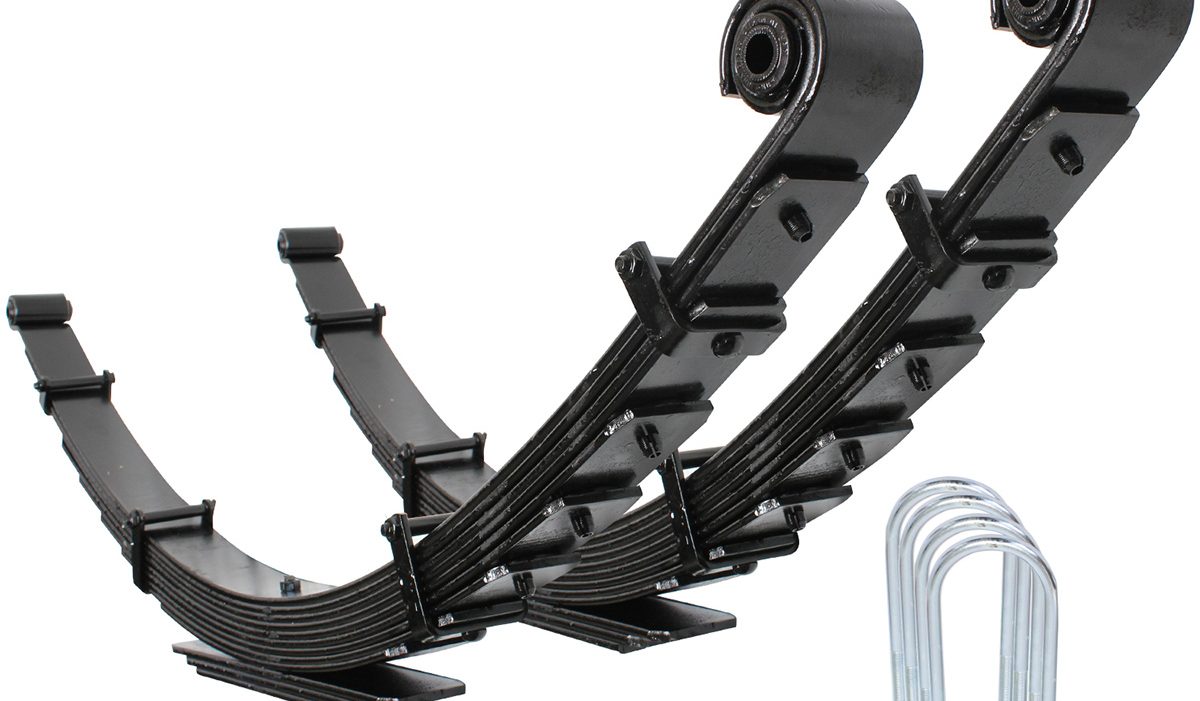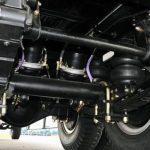Leaf springs play a pivotal role in many vehicles, offering essential support and suspension. A pressing question that often arises among enthusiasts and manufacturers alike is: “What are leaf springs made of?” This inquiry not only delves into the materials used but also the intricate manufacturing processes that shape these crucial components. In this article, we will embark on an in-depth exploration of the materials employed in crafting them and the processes that transform them into the sturdy, load-bearing devices we rely on.


The Anatomy of Leaf Springs
They have a long history of usage, dating back to ancient times when they were used in chariots and carriages. Over the centuries, they have evolved from simple wooden or iron bars to complex multi-leaf structures made of various materials. The basic components are:
- The central leaf or master leaf, which is the longest and thickest leaf connects to the axle through a central hole called the eye.
- The helper leaves or secondary leaves, are shorter and thinner leaves that are placed below the central leaf and decrease in length from the center to the ends.
- The clips or clamps, are metal bands that hold the leaves together and prevent them from sliding or splaying apart.
- The rebound clips are additional clips that are attached to the ends of the leaves and limit their rebound movement after compression.
- The shackles, are hinged links that connect the ends of the main leaf to the chassis of the vehicle and allow for length changes due to vertical deflection.
They differ in number, shape, and size based on their use. Here are the common types:
- Mono-leaf springs: Comprised of a single, typically tapered or parabolic leaf. They’re light and flexible but less durable and can crack.
- Multi-leaf springs: These have multiple flat or elliptical leaves, making them heavier and tougher than mono-leaf springs.
- Progressive leaf springs: These springs’ leaves change in thickness or width. They adjust from soft to hard spring rates based on load and road conditions.
What are leaf springs made of? Common Materials Used in Leaf Springs
Steel Alloys
Steel is the most common material used, especially for heavy-duty applications such as trucks, buses, trailers, and railway vehicles. Steel has high tensile strength and durability, which enable it to withstand high stresses and loads without breaking or deforming.
Different types of steel are chosen based on their composition and physical qualities. The most commonly used steel grades include:
- 5160 steel: A low-alloy type containing roughly 0.6% carbon and 0.9% chromium. Its high toughness and resistance to wear make it perfect for heavy-duty leaf springs.
- 9260 steel: This is a high-silicon variant with about 0.6% carbon and 2% silicon. Known for its flexibility and shock absorption, it’s typically chosen for light-duty leaf springs.
- 1095 steel: Containing about 0.95% carbon, this high-carbon steel is extremely hard and wear-resistant, making it great for high-performance leaf springs.
Composite Materials
Composite materials are relatively new entrants in the field of leaf springs, but they have gained popularity in recent years due to their advantages over conventional steel. Composite materials are made of two or more different materials that are combined to create a new material with enhanced properties. Some of the most common composite materials used in leaf springs are:
- Fiberglass is a composite material made of glass fibers embedded in a resin matrix. Fiberglass has a low weight and high strength-to-weight ratio, which improves fuel efficiency and handling of the vehicle. Fiberglass also has excellent corrosion resistance and thermal stability, which increase its lifespan and performance under varying environmental conditions.
- Carbon fiber is a composite material made of carbon fibers embedded in a resin matrix. Carbon fiber has an even lower weight and higher strength-to-weight ratio than fiberglass, which further enhances the fuel efficiency and handling of the vehicle. Carbon fiber also has superior stiffness and vibration damping, which reduce noise and improve ride quality.


Why These Materials Are Chosen
Steel’s Strength and Durability
Steel is a metal alloy that has high tensile strength and resistance to deformation, making it ideal for heavy-duty applications that require durability and reliability. Steel can withstand high loads, shocks, and stresses without breaking or losing their shape.
They are also resistant to corrosion, wear, and fatigue, which prolongs their lifespan and reduces maintenance costs. Some of the industries where steel leaf springs excel are mining, construction, agriculture, and military, where they are used in trucks, trailers, tractors, tanks, and other heavy equipment.
Composites’ Innovation and Lightweight Design
Composites, made of two or more substances, offer enhanced properties. Tailored for specific needs like weight reduction and performance, composite leaf springs, crafted from fiber-reinforced polymers like carbon fiber, are light yet strong. They boost fuel efficiency, speed, and handling while offering superior comfort and noise reduction compared to steel springs. They excel in sports cars, racing vehicles, electric models, and aerospace applications.


Manufacturing Process: From Raw Material to Leaf Spring
Traditional Hot Forming
Hot forming is the traditional method of manufacturing steel leaf springs. It involves heating the steel to a high temperature (usually above 800°C) and then shaping it into the desired form using dies, hammers, presses, or rollers. The hot-forming process consists of three main stages:
- Heating: The steel is heated in a furnace or an induction coil until it reaches its austenitizing temperature, which is the temperature at which the steel transforms into a single-phase structure called austenite. This makes the steel more ductile and malleable, allowing it to be easily shaped.
- Shaping: The heated steel is transferred to a forming machine, where it is shaped into the desired form using dies, hammers, presses, or rollers. The shaping process can be done in one or more steps, depending on the complexity of the design. The shaping process also determines the curvature and thickness of the leaf spring.
- Cooling: The shaped steel is cooled down rapidly using water or air jets. This causes the steel to undergo a phase transformation from austenite to martensite, which is a hard and brittle structure. This increases the strength and hardness of the steel but also reduces its ductility and toughness.
Modern Cold Forming
Cold forming is a modern method of manufacturing steel leaf springs that does not involve heating the steel. Instead, it uses high pressure and speed to deform the steel at room temperature or slightly above.
The cold-forming process consists of two main stages:
- Preparation: The steel is cut into blanks or strips of appropriate size and shape using shears or saws. The steel is then cleaned and lubricated to remove any dirt or rust and reduce friction during forming.
- Forming: The prepared steel is fed into a forming machine, where it is deformed into the desired shape using dies or rollers. The forming machine can apply various types of forces, such as bending, drawing, extruding, or rolling. The forming machine can also perform multiple operations in one cycle, such as punching holes or cutting edges.
Composite Manufacturing
Composite manufacturing for leaf springs involves layering materials and bonding with resin. The process includes:
- Layering: Composite sheets are cut, arranged, and layered according to design specifications for strength and stiffness.
- Resin Infusion: These layers are placed in a mold, air is vacuumed out, and resin is injected to bind them.
- Curing: The resin-infused material is heated until the resin solidifies, forming a robust leaf spring.
- Finishing: The spring is trimmed, polished, inspected for defects, and then packaged.


In conclusion, understanding this question offers invaluable insights into the innovation and engineering behind our vehicles. The fusion of carefully selected materials and meticulous manufacturing processes ensures that these essential components continue to support and enhance our driving experiences for years to come.






